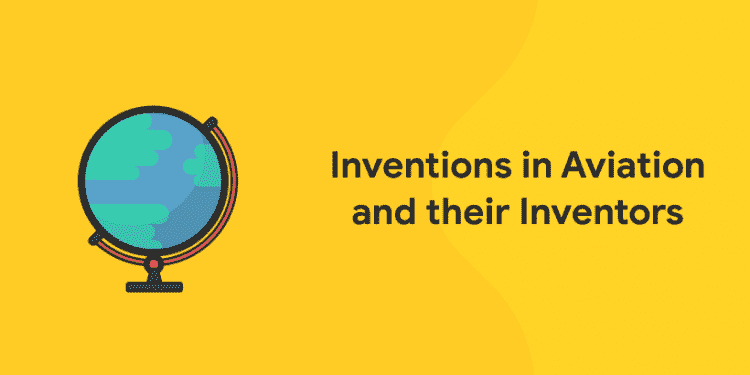Table of Contents
Flying was a fascination for the human race for years, still, it remains an excitement to experiment with technological innovation in the aviation sector. In order to, fulfill the desire, we know humans have used the feathers and jumped to get the feel of flying and sometimes enjoyed flying kites! This long quest and experiment by the people lead to the invention of aviation step by step, and now it has landed on neighboring planets. In this article, let us have look at the history of aviation and readers can take a brief list of Inventions in Aviation and their Inventors.
The term aviation was coined by French pioneer Guillaume Joseph Gabriel de La Landelle, in 1863, from the stem Latin avis meaning bird and ation meaning action or progress. From the early tower jumping to the modern jet flights aviation, has really progressed. There are numerous airports across the world, and this really helped to reduce the distance and the world became closer. The airways or the air routes route along which airplanes fly from airport to airport became busy! But the pandemic affected the aviation industry too. As the travel restriction was imposed all over the world, a great loss was tolerated by all sectors under the industry.
Glimpse through Aviation History
As the gliders provided the groundwork for heavier-than-air craft, in the late 19th century and by the early 20th century, advancements in engine technology and aerodynamics gained control, thus the powered flight possible for the first time. The modern airplane with its characteristic tail was instituted by 1909 and from then on the history of the airplane became fastened to the development of more and more powerful engines. Let us have a glance through aviation history.
Primitive Era
- 810–887 AD – Andalusian scientist Abbas ibn Firnas is claimed to have made a jump in Córdoba, Spain, covering his body with vulture feathers and attaching two wings to his arms
- The kite may have been the first form of man-made aircraft. It was invented in China possibly may be in the 5th century BC by Mozi and Lu Ban (Gongshu Ban)
Modern Theory begins
- 1670, Francesco Lana de Terzi published a work. In his work, he has suggested lighter than air flight would be possible by using copper foil spheres that, containing a vacuum, would be lighter than the displaced air to lift an airship.
- 1709, Bartolomeu de Gusmão presented a petition to King John V of Portugal, begging for support for his invention of an airship
1783 was an Epic year!
- 04 June – the Montgolfier brothers demonstrated the unmanned hot air balloon at Annonay, France.
- 27 August – Jacques Charles and the Robert brothers (Les Freres Robert) launched the world’s first unmanned hydrogen-filled balloon, from the Champ de Mars, Paris.
- 19 October – the Montgolfiers launched the first manned flight, a tethered balloon with humans on board, at the Folie Titon in Paris.
Airships
- 1884, when the first fully controllable free-flight electric-powered airship, La France, by Charles Renard and Arthur Krebs was made in a French Army.
- Brazilian Alberto Santos-Dumont effectively combined a balloon with an internal combustion engine.
- 19 October 1901, Brazilian Alberto Santos-Dumont flew airship Number 6 over Paris from the Parc de Saint-Cloud around the Eiffel Tower and back in under 30 minutes
Sir George Cayley – Father of the Airplane
- Made the first modern aircraft
- Sir George Cayley was first called the father of the Airplane in 1846.
Other Major Events
- 1842 – Henson’s design for an aerial steam carriage broke new ground.
- 1871, Wenham and Browning made the first wind tunnel.
- 1880 – William Frost from Pembrokeshire, Wales started his project and after 16 years, he designed a flying machine and in
- 1894 – William Frost won a patent for a Frost Aircraft Glider.
- Wright brothers – On December 17, 1903, the first flight by Orville Wright, of 120 feet (37 m) in 12 seconds, was recorded in a famous photograph. Wilbur Wright flew 852 feet (260 m) in 59 seconds in the fourth flight of the same day,
- 13th January 1908 – Henri Farman flew another type of aircraft to win the Deutsch-Archdeacon Grand Prix d’Aviation prize for a flight. This aircraft flew a distance of more than a kilometer and landed at the point where it had taken off. And, the flight lasted 1 minute and 28 seconds
- 1877 – Enrico Forlanini developed an unmanned helicopter powered by a steam engine.
- 1907 – Paul Cornu’s helicopter was built and it was the first manned flying machine to have risen from the ground using rotating wings instead of fixed wings.
- 1907 – First manned helicopter is known to have risen off the ground was on a tethered flight and was developed by the Breguet-Richet Gyroplane.
World Wars and Aviation
The years between World War I and World War II remarked great advancements in aircraft technology. Airplanes developed from low-powered biplanes made from wood and fabric to sleek, high-powered monoplanes made of aluminum were witnessed in this period.
Commercial aviation grew swiftly after World War II, using mostly ex-military aircraft to transport people and cargo. The first commercial jet airliner was the British de Havilland Comet.
Jet Engine
A giant leap forward in the aviation industry was in 1937 when British inventor and engineer Frank Whittle tested the world’s first jet engine. This engine sucked air through forward-facing compressor blades. This air then enters a combustion chamber, where it is mixed with fuel and burned. A superheated current of gases then raced from the tailpipe, pushing the engine and the aircraft forward.
- In 1939, aftermath, Hans Pabst van Ohain of Germany took Whittle’s basic design and powered the first jet-aircraft flight.
Over the Mars
19th April 2021 marked another leap in aviation history. An unmanned helicopter was flown on Mars by NASA, making it humanity’s first controlled powered flight on another planet. The Ingenuity helicopter rose to a height of 3 meters, and fluttered in a stable holding position for 30 seconds, after a vertical take-off. The flight was filmed by its accompanying rover, Perseverance.
Practice Quiz on Indian Airways for bank Exams
Inventions in Aviation and their Inventors
1: Who was the first woman President of India?
| Year of Invention | Aviation invented | Inventor |
| 1783 | Hot air balloon | Jacques and Joseph Montgolfier |
| 1979 | Parachute | AJ Garnerin |
| 1852 | Airship (non-rigid) | Henri Giffard |
| 1853 | Gliders | Sir George Cayley |
| 1900 | Airship (rigid) | G.F. von zeppelin |
| 1903 | Airplane | Orville and Wilbur Wright |
| 1924 | Helicopter | Etienne Oehmichen |
| 1926 | Rocket | Robert Goddard |
| 1937 | Jet Engine | Sir Frank Whittle |
| 1955 | Hovercraft | Christopher Cockerell |
Air Ports
There is a total of 17,678 commercial airports in the world as per the Airports Council International (ACI) World Airport Traffic Report.
Check the airports of India, click here.
List of International Airports, click here.
Airlines of India
On 18 February 1911, the first commercial aviation flight in India took place. This aircraft called, a Humber biplane, which was shipped from England specifically for the event, was flown by French aviator Henri Pequet.
JRD Tata
- Tata acquired the first pilot license issued in India on 10th February 1929.
- Later on, he was known to be the father of Indian civil aviation.
- J R D Tata and Nevill Vintcent worked together and founded India’s first commercial airline, Tata Airlines in 1932, which became Air India in 1946. Air India is now India’s national airline.
- Jehangir Ratanji Dadabhoy Tata (29 July 1904 – 29 November 1993) was an Indian aviator, industrialist, entrepreneur, and chairman of Tata Group.
- He is the founder of several industries under the Tata Group, including Tata Consultancy Services (TCS), Tata Motors, Titan Industries, Tata Salt, Voltas, and Air India.
- Awards – In 1955 and 1992, received two of India’s highest civilian awards the Padma Vibhushan and the Bharat Ratna.
The takeaway for the Exam
- Incumbent Ministers of Civil Aviation – Jyotiraditya Scindia
Types of Airlines
Scheduled Airlines
| Year | Airline | Headquarter |
| 1946 | Air India | Delhi |
| 2005 | SpiceJet | Gurgaon |
| 2005 | Air India Express | Kochi |
| 2005 | Go First | Mumbai |
| 2006 | IndiGo | Gurgaon |
| 2014 | AirAsia India | Bengaluru |
| 2015 | Vistara | Gurgaon |
Cargo Airlines
| Year | Airline | Headquarter |
| 1995 | Blue Dart Aviation | Chennai |
| 2016 | Quikjet Airlines | Bengaluru |
| 2018 | SpiceXpress | Delhi |
Regional Airlines
| Year | Airline | Headquarter |
| 1996 | Alliance Air | Delhi |
| 2015 | TruJet | Hyderabad |
| 2017 | Zoom Air | Delhi |
| 2019 | Air Heritage | Dehradun |
| 2019 | Star Air | Bengaluru |
| 2021 | FlyBig | Gurugram |
Charter Airlines
| Year | Airline | Headquarter |
| 1983 | Supreme Airlines | Jaipur |
| 1985 | Pawan Hans | Delhi |
| 1997 | Deccan Charters | Bengaluru |
| 2005 | Confident Airlines | Bengaluru |
| 2007 | Dove Airlines | Kolkatta |
| 2012 | Spirit Air | Bengaluru |
| 2016 | Fly Hornbill | Guwahati |
| 2017 | Fly Divine | Indore |
So, all these regarding the aviation history and major inventions contributed to this industry with a list of inventors. The quest of the human race has conquered space with the help of aviation technology and we can hope for more in the coming years.














